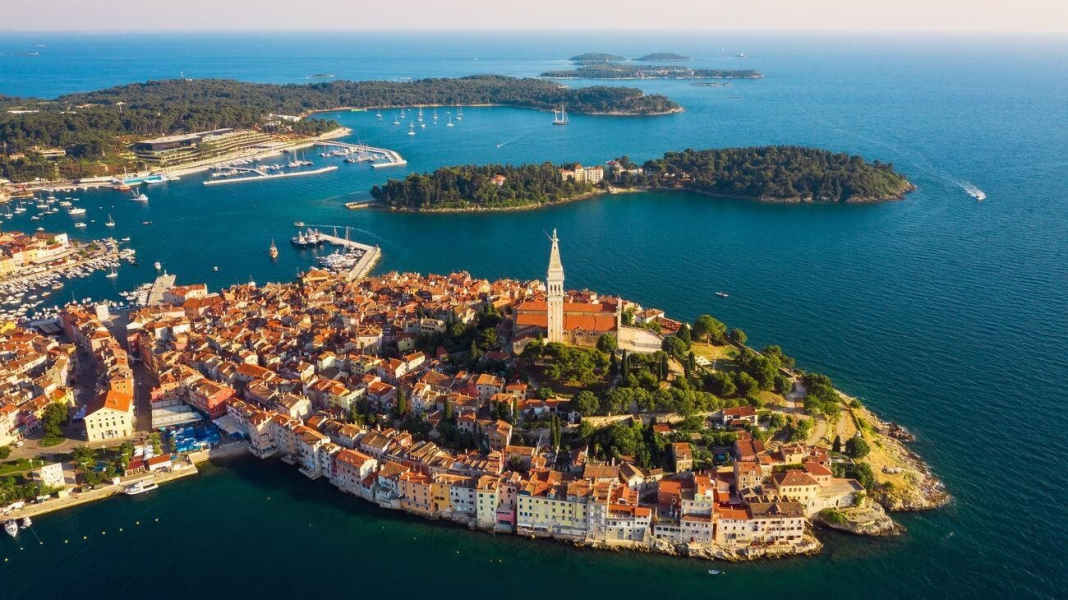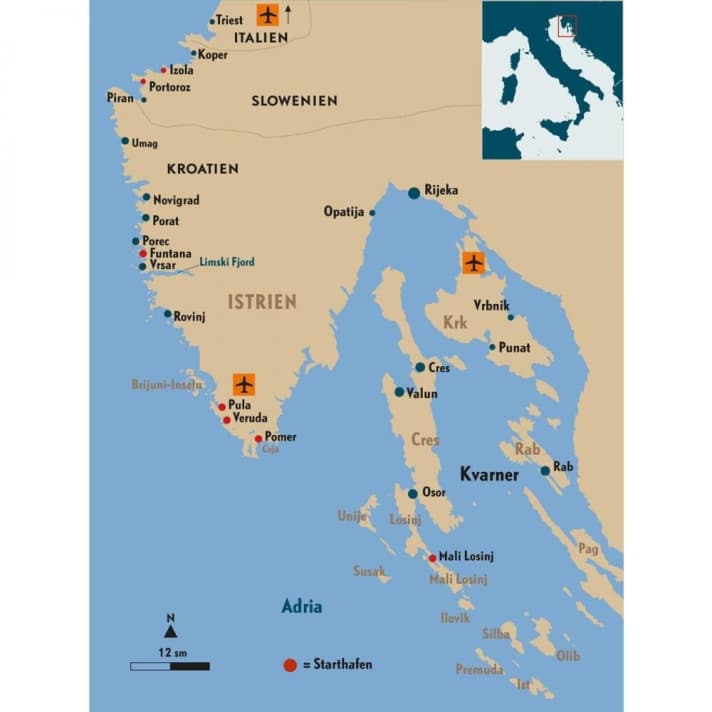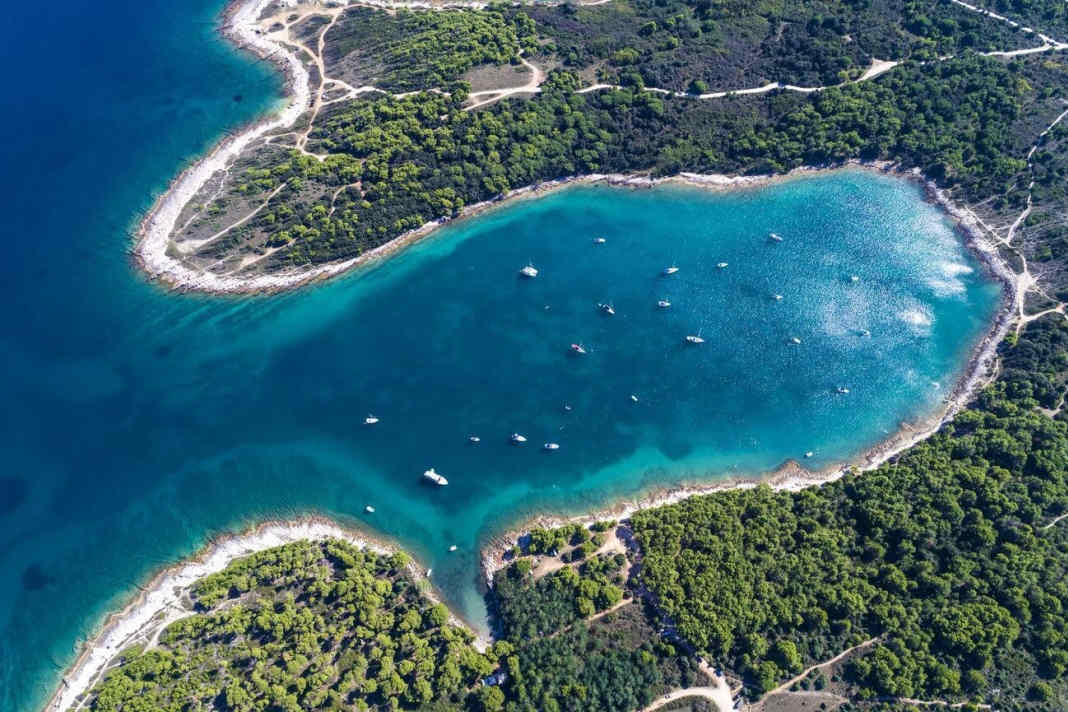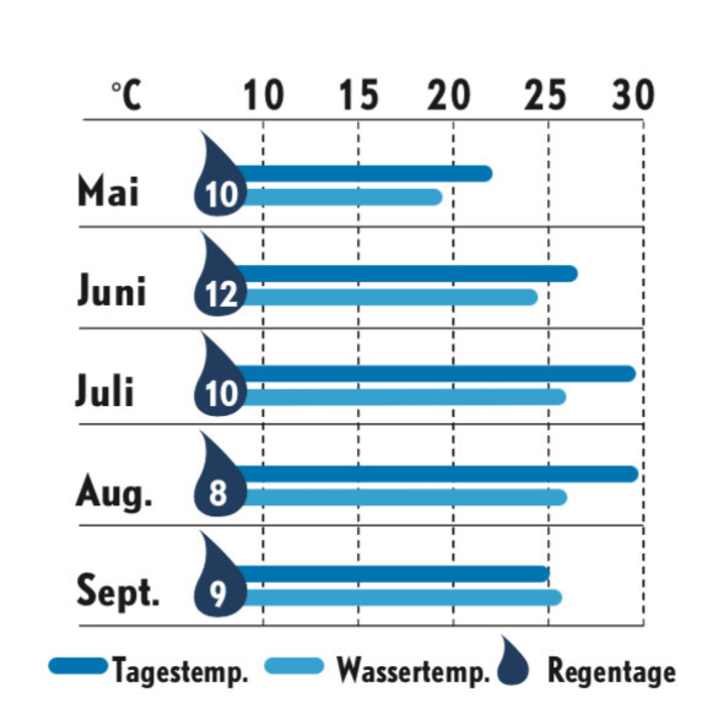

ARRIVAL
Istria is for the Car journey from the southern half of Germany. From Munich, for example, it is 600 kilometres to Pula or Veruda, where there are various charter providers. To get there, you have to add the toll in Austria, Slovenia and Croatia, depending on the route (information e.g. on the website of the ADAC ). Cars can usually be parked somewhere near the harbour in guarded car parks for a weekly fee of 60 to 100 euros. Alternatively, you can also take a Flixbus, for example from Munich, directly to Pula overnight, which takes around 10 hours, but is also very cheap at under 40 euros each way in some cases.
Alternatively there areFlightsespecially afterPulaless often to the islandKrk. You can also useTriesteand then take off from Slovenia. The approximately one-hour transfer is relatively expensive, however, and should be organised in advance via the agency or the fleet operator.






CHARTER
The fleet on offer in the area is huge, and various starting harbours are possible: if you drive to Istria by car, you can start in Funtana, Pula, Veruda or Pomer start. Further south, Opatija, the island ofKrk (Punat) orMali Losinj to. However, the latter two island destinationspartly ferry trips which can become a time bottleneck, at least in the high season. Then queues or traffic jams can become aDelays provide.
If you decide to visit the charming north of Istria and don't want to sail with the majority of charter crews, who usually head south quickly, you can also start in Slovenia (Portoroz and Izola) and then sail leisurely through the beautiful towns of Istria. The journey by car is then around 100 kilometres shorter than to Pula. The only disadvantage is thatCrossing the border into and out of Croatia must. However, if you do this via Piran and Umag, the whole procedure takes about 30 minutes.

WIND & WEATHER
In the summer months, the Istrian coast is very often blown by theMaistral, a lighter wind from the north-westt. It develops gradually in the morning and usually reaches 3 to 4 Beaufort in the afternoon, dying down again relatively quickly towards the evening. In Istria, however, there are also longer calm days or a classic sea breeze.
Strong winds and storms canBora from the north-eastwhich can be particularly severe in the early and late season, but is also always good for surprises in summer. This is particularly true for theKvarnerwhich has two notorious sites near Rijeka and Senji Bora aisles has. The wind there can be extremely strong, so crews should get there in good time if a bora is forecast.Seek protection. The bora often blows in very clear, good weather.
From the south blows the so-calledJugowhich almost always has aDeterioration of the weather with cloud cover and rain. It is rare in summer and often alternates with the bora in the early and late season. Prolonged jugo bringshigh swellas it has a long approach route across the Adriatic.
The Croatian weather service predicts bora and jugo quite reliably. Otherwise, the usual online or app weather information sites such as Windy , Windfinder (Pro version!) and others. If the forecast is poor, you should always consult the Croatian forecasts.
NAVIGATION & SEAFARING
The coast of Istria isnavigationally not too much of a problem Compared to the south, there are slightly fewer flat and dangerous passages, the most important ones are buoyed. Please note theBrijuni National Park north of Pula, which includes some restricted areas. There are narrow passages between some islands, such as Losinj and Cres, Ist and Molat, in which even stronger winds can be expected. Power and wind nozzles can stand. You canimpassable in strong windsbecome.
The following must be observed in the districtBuoy fieldswhich the state allocates to leaseholders and of which there are now around 70 to 80 throughout the country. Those who use the buoys have to pay, with prices varying from around2 to 5 euros per metre of boat, depending on the location and popularity of the field. Important: If you want to anchor, you mustMaintain a distance of at least 150 metres from the fields (previously 250 metres). There are sometimes disputes about this regulation: Some operators also try to charge crews who anchor close to the fields. In such cases, you should keep a generous distance to avoid trouble from the outset.
Not all buoy ground tackle is strong enough and well maintained. In Croatia, the operators are not liable for the condition of the buoys, so you should not blindly trust them in bad weather.
Important in Croatia: The charter crew must include someone withRadio licence (SRC or higher), this is now a requirement. And: If aDinghy with outboard motora person with a driving licence must sit in it, regardless of how much horsepower they have.
HARBOURS AND ANCHORAGES
Along the coast there is a denseNetwork of good marinas, all have mooring lines.
Municipal city harbours often offer relatively few pitches, most are equipped with mooring lines, electricity and water are relatively common, but sanitary facilities are not always available. Costs: Outside the high season between40 and 50 euros per nightfor a twelve-metre yacht,Urban investors are cheaper.
TheChoice of safe anchorages is something in Istriarestrictedafter the southern tip of the islands, there is significantly more choice. PartlyChargeable buoy fieldsbut here in the north they are even rarer than in the south.
LITERATURE & NAUTICAL CHARTS
"Küstenhandbuch Kroatien, Band 1", by Müller/Strassburger, Delius Klasing, 29.90 euros. "Croatia, 888 harbours and bays" by K.-H. Beständig, Eigenverlag, 29.90 euros. "Sportbootkartensatz 7, Adria 1", Delius Klasing, 59.90 euros.
TERRITORY CHARACTERISTICS
Croatia's north is the classicCar journey destination on the AdriaticIf you start in Pula or Funtana, you can be there from the Munich area in around six to seven hours. There, crews can expect one of manyUnderestimated territory. The approximately 50 nautical miles longMainland coast of Istria is very scenic, and many of the towns along the north-south route are picturesque: Rovinj with its peninsula overlooked by the church, Pula with its old Roman amphitheatre, and smaller, pretty coastal towns such as Vrsar are also well worth a visit.
However, along the coast there arefewer offshore islandsthan in the south of Croatia, which means that theAnchoring not so often possible. In addition, Istria is frequented by many land-based tourists in summer, so it can get crowded when going ashore. This explains why many crews start here,the bow immediately to the south and sail quickly to the islands off Kvarner, Mali Losinj, Cres, Krk or Silba and Premuda. The area there offers the typicalIsland hopping Croatiathat many crews love so much:A new island every day to control,Short distancesalways a good selection of bays and harbours only two or three hours sailing distance away. And in summer oftenmoderate windsthat do not overtax even beginner crews.
However, it is definitely worthAlternative onceIstria and Sloveniato explore. You can also take a detour into the deep, mainland-cuttingLimski Fjord a good place to eat mussels. If you're not afraid of the expensive harbour fee, you should also visit the National Park of theBrijuni Islands where Tito had his summer residence. There is now a museum there, and you can also marvel at exotic animals that the dictator acquired and which have been cared for there ever since. The change of territory to Slovenia is also worthwhile,Piran is without question one of the pearls of the Adriatic.
Due to the uncomplicated journey, many crews use the area for a week's cruise. From Pula to the islands such as Olib or Molat and back is just about120 nautical miles, ideal for a week. If you sail northwards from Pula, a visit to Piran adds up to 100 nautical miles. If you want to see both, you should plan two weeks, the contrast between islands and coast is very attractive.

